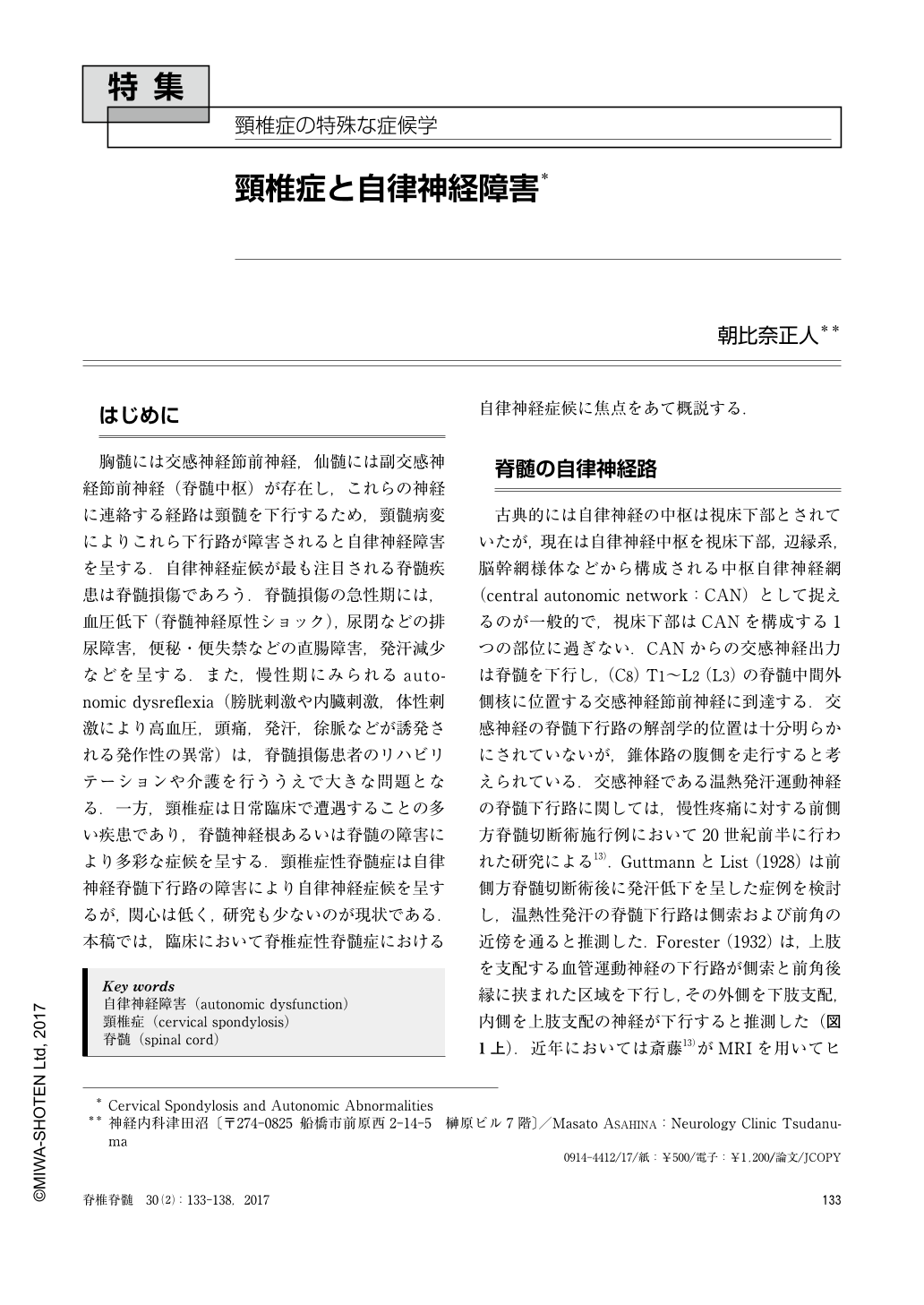40 0 0 0 OA 自律神経障害はこう診断し治療する
- 著者
- 朝比奈 正人
- 出版者
- 日本神経治療学会
- 雑誌
- 神経治療学 (ISSN:09168443)
- 巻号頁・発行日
- vol.33, no.3, pp.368-372, 2016 (Released:2016-11-10)
- 参考文献数
- 14
Clinically it is very important to diagnose and treat autonomic symptoms such as syncope, urinary problems and sweat abnormalities. Vasovagal syncope, the most common syncopal disorder, usually develops under 40 years old. As the sensitivity of head–up tilt test is low, history taking is more important for the diagnosis. Carotid sinus syncope usually develops over 60 years old and its diagnosis is confirmed based on the evidence of bradycardia and hypotension induced by stimulation to the carotid sinus. Orthostatic hypotension is defined as a sustained reduction of systolic blood pressure of at least 20mmHg or diastolic blood pressure of 10mmHg within 3 minutes of standing or during head–up tilt test. Non–pharmacological management is important : salt supplementation, fluid intake and avoiding precipitating factors such as high carbohydrate meals, hot environments, alcohol and vasodilator drugs. Vasopressor drugs, which are used for treatment of orthostatic hypotension, can cause or aggravate recumbent hypertension. Urinary dysfunction is classified into storage and voiding symptoms. Anticholinergic drugs, which are used for treatment of storage symptoms, may exacerbate cognitive impairment. In regard to impaired voiding, clean intermittent selfcatheterization is preferred in patients having over 100ml of residual urine. Sudomotor abnormalities include hyperhidrosis and hypo/anhidrosis. For focal hyperhidrosis such as palmoplantar hyperhidrosis treatment like aluminium chloride application, tap water iontophoresis and thoracic sympathectomy may be performed. For acquired idiopathic generalized anhidrosis corticosteroid therapy is often effective.
6 0 0 0 OA よくみる自律神経症候:失神・めまい・たちくらみ
- 著者
- 朝比奈 正人
- 出版者
- 日本神経治療学会
- 雑誌
- 神経治療学 (ISSN:09168443)
- 巻号頁・発行日
- vol.35, no.3, pp.222-225, 2018 (Released:2018-12-25)
- 参考文献数
- 20
Autonomic dysfunction presents several symptoms and signs, such as constipation, urinary problems and sweat abnormalities. Fainting (syncope) or swooning (presyncope) is one of the more common autonomic symptoms, and medical staff require to obtain knowledge and skill to manage syncope. Vasovagal syncope and orthostatic hypotension are representative of diseases which can cause syncope. This review will outline the current understanding of diagnosis, pathophysiology and management of vasovagal syncope and orthostatic hypotension for medical staff.
2 0 0 0 頸椎症と自律神経障害
- 著者
- 朝比奈 正人
- 出版者
- 三輪書店
- 雑誌
- 脊椎脊髄ジャーナル (ISSN:09144412)
- 巻号頁・発行日
- vol.30, no.2, pp.133-138, 2017-02-25
はじめに 胸髄には交感神経節前神経,仙髄には副交感神経節前神経(脊髄中枢)が存在し,これらの神経に連絡する経路は頸髄を下行するため,頸髄病変によりこれら下行路が障害されると自律神経障害を呈する.自律神経症候が最も注目される脊髄疾患は脊髄損傷であろう.脊髄損傷の急性期には,血圧低下(脊髄神経原性ショック),尿閉などの排尿障害,便秘・便失禁などの直腸障害,発汗減少などを呈する.また,慢性期にみられるautonomic dysreflexia(膀胱刺激や内臓刺激,体性刺激により高血圧,頭痛,発汗,徐脈などが誘発される発作性の異常)は,脊髄損傷患者のリハビリテーションや介護を行ううえで大きな問題となる.一方,頸椎症は日常臨床で遭遇することの多い疾患であり,脊髄神経根あるいは脊髄の障害により多彩な症候を呈する.頸椎症性脊髄症は自律神経脊髄下行路の障害により自律神経症候を呈するが,関心は低く,研究も少ないのが現状である.本稿では,臨床において脊椎症性脊髄症における自律神経症候に焦点をあて概説する.
1 0 0 0 OA 自律神経疾患の治療の進歩
- 著者
- 荒木 信之 朝比奈 正人
- 出版者
- 日本神経治療学会
- 雑誌
- 神経治療学 (ISSN:09168443)
- 巻号頁・発行日
- vol.35, no.5, pp.624-627, 2018 (Released:2019-05-15)
- 参考文献数
- 56
Article on novel development of neurological treatment published in 2017 were reviewed.Neurogenic orthostatic hypotension (OH) and postprandial hypotension (PH) : According to the Grading of Recommendations Assessment, Development and Evaluation (GRADE), abdominal binder, midodrine and droxidopa were assessed as strong recommendation for OH, and acarbose as strong recommendation for PH.Postural tachycardia syndrome (PoTS) : Ivabradine showed a possibility of effectiveness for PoTS, but.droxidopa did not improve significantly.Vasovagal syncope : Fluoxetine improved vasovagal syncope in patients with anxiety. Dual–Chamber pacing significantly reduced the recurrence of vasovagal syncope.Urinary disturbance : Solifenacine increased maximum cystometric capacity, and injection of onabotulinum toxin A reduced frequency of urinary incontinence.Chronic constipation : Lubiprostone increased spontaneous bowel movements in diabetic patients with constipation. Low dose linaclotide improved chronic idiopathic constipation. The phase II trial suggest that a clinically optimal dose of elobixibat is 10mg/day for Japanese patients with chronic constipation. Naldemedine significantly increased spontaneous bowel movements in patients with opioid–induced constipation.Anhidrosis : Degranulation and shrinkage of dark cells in eccrine glands and elevated serum carcinoembryonic antigen were seen in patients with acquired idiopathic generalized anhidrosis (AIGA). The Japanese guideline of AIGA was revised in 2017.Hyperhidrosis : Percutaneous and oral oxybutynin administration improved hyperhidrosis.
